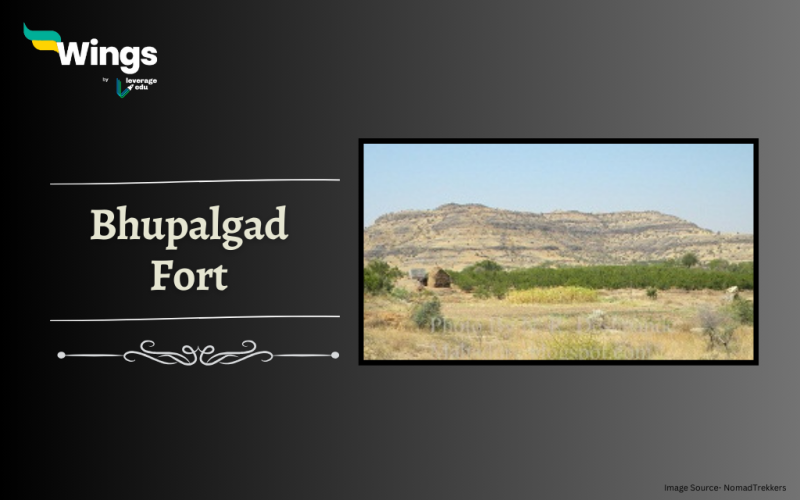Bhupalgad Fort, also known as Banurgad Fort, is a historical fort located in the Khanapur taluka of Sangli district, Maharashtra, India. Moreover, it was strategically situated on the border of the Maratha Empire during the reign of Chhatrapati Shivaji Maharaj and had an important part in the region’s history. Read on to learn about the History of the Bhupalgad Fort, its features and other interesting facts!
Table of Contents
| Also known as | Banurgad Fort |
| Commissioned during | Shivali Maharaj’s period |
| Location | Sangli district, Banur, Maharastra |
| Type | Hill Fort |
| Height | 2825ft |
| Timings | Open Everyday |
| Entry Fee for fort | Free Entry |
| Camera | Allowed and Free |
Historical Timeline of Bhupalgad Fort
Here is the Historical Timeline of Bhupalgad Ford:
- Early history: The exact date of construction of Bhupalgad Fort is unknown, but historical documents suggest it existed before the reign of Shivaji Maharaj.
- Some sources claim it was built by Chhatrapati Shivaji Maharaj himself, while others believe it was constructed earlier by a king named Bhupal Singh, hence the name.
- Shivaji era: During Shivaji Maharaj’s rule, Bhupalgad Fort held great importance as a border outpost of the Maratha Empire.
- The fort was strategically located, serving as an important defence point against enemy invasions.
- Consequently, Shivaji Maharaj appointed Firangoji Narsala as the fort’s governor.
- Battle of Bhupalgad (1679): A significant event in the fort’s history occurred in 1679.
- Following a complex political situation, Sambhaji Maharaj, son of Shivaji Maharaj, joined forces with the Mughals.
- As part of this alliance, Sambhaji and the Mughal general Diler Khan besieged Bhupalgad Fort.
- In addition, since Sambhaji was considered the Maratha prince, the fort’s commander, Firangoji Narsala, chose not to fight against him and instead fled to join Shivaji Maharaj at Panhalgad Fort.
- The fort was subsequently captured by the Mughals, leading to a brutal act where Diler Khan ordered the amputation of captured Maratha soldiers’ hands and legs.
- This incident deeply affected Sambhaji, and he eventually rejoined the Maratha side with the help of his father’s clever intervention.
- Later history: After the Battle of Bhupalgad, the fort changed hands several times between the Marathas and the Mughals. Eventually, it fell into disrepair and is now in ruins.
Features of Bhupalgad Fort
Furthermore, though largely in ruins, Bhupalgad Fort still bears witness to its past glory. Here are some of its notable features:
- Location: The fort is situated on a hilltop at an elevation of 2825 feet above sea level, offering a panoramic view of the surrounding landscape.
- Size: Bhupalgad Fort was once a massive structure, spread over an area of more than 400 acres.
- Fortifications: The fort had a strong stone wall surrounding the perimeter and a citadel on a central hill for added defence.
- Water reservoir: The fort had a water reservoir within its walls to sustain its inhabitants during sieges.
- Temple and Samadhi: A Mahadev temple and a samadhi (tomb) believed to belong to Bahirji Naik, Shivaji Maharaj’s head of intelligence, are present within the fort complex.
Also Read: Purandar Fort History: Features, Facts, Timings & More
Interesting Facts about Bhupalgad Fort
Additionally, here are some Interesting Facts about the Bhupalgad Fort:
- The fort is also known as Banurgad due to the village of Banur located within its boundaries.
- The climb to the fort is considered relatively easy, making it accessible to visitors of all fitness levels.
- Despite being in ruins, Bhupalgad Fort offers a glimpse into the Maratha Empire’s history and the strategic significance of forts during that era.
While its past grandeur may have faded, Bhupalgad Fort still stands as a testament to the resilience and strategic brilliance of the Maratha Empire.
Did you know? The word “gad” that you might notice at the end of the name like Bhupalgad translates to “Fort!”
Other Attractions near Bhupalgad Fort
The other attractions that you can visit near Bhupalgad Fort are:
| Sangli Fort | Bahirji Naik Tomb |
| Palshi Village | Banling Temple |
| Vishalgad Fort | Krishna River |
Relevant Blogs
That’s all about Bhupalgad Fort History! If you want to know more about topics like this, then visit our general knowledge page! Alternatively, you can also read our blog on general knowledge for competitive exams!
 One app for all your study abroad needs
One app for all your study abroad needs













